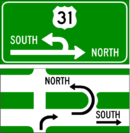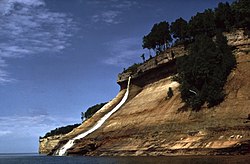Portal:Michigan/Selected article
| This page is currently inactive and is retained for historical reference. Either the page is no longer relevant or consensus on its purpose has become unclear. To revive discussion, seek broader input via a forum such as the village pump. |
| Note: Article entries are now being transcluded directly on the main portal page. However, this page should be retained for historical reference. |
Selected article 1
Portal:Michigan/Selected article/1
The Michigan State Spartans are the athletic teams that represent Michigan State University. The school's athletic program includes 23 varsity sports teams. Their mascot is a Spartan warrior named Sparty, and the school colors are green and white. The university participates in the NCAA's Division I-A and in the Big Ten Conference in all Varsity sports except ice hockey, which competes in the Central Collegiate Hockey Association. Michigan State offers 11 varsity sports for men and 12 for women. The university's athletic director is Mark Hollis, who was promoted to the position on January 1, 2008. Hollis replaced Ron Mason, who served as head hockey coach from 1979 to 2002, retiring with a 608–261–64 record at MSU. MSU's football team has won or shared six national championships in 1951, 1952, 1955, 1957, 1965, and 1966, and has won the Rose Bowl in 1954, 1956, and 1988.Selected article 2
Portal:Michigan/Selected article/2
Mackinac Island (/ˈmækɪnɔː/ MAK-i-naw) is an island covering 3.8 square miles (10 km2) in land area, belonging to the U.S. state of Michigan. It is located in Lake Huron, at the eastern end of the Straits of Mackinac, between the state's Upper and Lower Peninsulas. The island was home to a Native American settlement before European exploration began in the 17th century. It served a strategic position amidst the commerce of the Great Lakes fur trade. This led to the establishment of Fort Mackinac on the island by the British during the American Revolutionary War. It was the scene of two battles during the War of 1812. In the late 19th century, Mackinac Island became a popular tourist attraction and summer colony. Much of the island has undergone extensive historical preservation and restoration; as a result, the entire island is listed as a National Historic Landmark. It is well known for its numerous cultural events; its wide variety of architectural styles, including the famous Victorian Grand Hotel; and its ban on almost all motor vehicles. More than 80 percent of the island is preserved as Mackinac Island State Park.Selected article 3
Portal:Michigan/Selected article/3
The Detroit Tigers are a Major League Baseball team based in Detroit. The Tigers are in the American League Central Division and are the 2006 American League Champions. Since 1992 the team, operating as Detroit Tigers, Inc., a subsidiary of Ilitch Holdings, Inc., has been owned by Mike Ilitch, founder of Little Caesars Pizza and owner of the NHL's Detroit Red Wings.The Tigers defeated Oakland, 4 games to none in the 2006 American League Championship Series but lost to the St. Louis Cardinals, 4 games to 1 in the 2006 World Series. The Tigers' last won the World Series in 1984, beating the San Diego Padres 4 games to 1. Since 2000, the Tigers have played in Comerica Park which replaced the aging Tiger Stadium.
Selected article 4
Portal:Michigan/Selected article/4

A Michigan left, sometimes known as a median U-turn or median U-turn crossover, is an automobile traffic maneuver in which a right turn and a unidirectional U-turn replace a prohibited left turn. The term comes from the fact that the arrangement is quite common along Michigan roads and highways, and extremely rare anywhere else in the United States.
Michigan lefts occur at intersections where at least one road is a divided highway or boulevard. Left turns onto the divided highway are prohibited. Instead, drivers on roads that cross the highway are directed to turn right. Within a 1/4 mile (400 m), they queue into a designated U-turn lane in the median. When traffic clears they complete the U-turn and go back through the intersection. For additional safety purposes, the U-turn lane is designed so traffic only flows through it one-way.
Selected article 5
Portal:Michigan/Selected article/5

Pictured Rocks National Lakeshore is a U.S. National Lakeshore on the shore of Lake Superior in the Upper Peninsula. It extends for 42 miles (67 km) along the shore and covers 73,236 acres (318 km²). The park offers spectacular scenery of the hilly shoreline between Munising, Michigan and Grand Marais, Michigan, with natural arches, waterfalls, and sand dunes.
The name "Pictured Rocks" comes from the 15 miles (24 km) of colorful sandstone cliffs northeast of Munising. The cliffs are up to 200 feet (60 m) above lake level and have been naturally sculptured into shallow caves, arches, formations that resemble castle turrets, and human profiles, among others. Near Munising, visitors also can view Grand Island, most of which is included in the Grand Island National Recreation Area and is preserved separately.
Selected article 6
Portal:Michigan/Selected article/6

The University of Michigan, Ann Arbor (called Michigan or U of M) is a public university. It is the state's oldest university and the flagship campus of the University of Michigan which also includes campuses in Flint and Dearborn. Founded in 1817 as the Catholepistemiad, or University of Michigania, about 20 years before the Michigan Territory became a state, the university moved to Ann Arbor in 1837 onto 40 acres (16 ha), now Central Campus. The university has expanded to include more than 584 major buildings and transformed its academic program from a classical curriculum to one that includes science and research. U of M has one of the world's largest living alumni groups at 460,000. It owns the U of M Health System and has one of the largest research expenditures of any American university, surpassing $1 billion dollars a year. Its athletic teams, called the Wolverines, are members of the Big Ten Conference and the Central Collegiate Hockey Association. The football team plays in Michigan Stadium, also known as "The Big House," the largest football stadium in the world.
Selected article 7
Portal:Michigan/Selected article/7
The Toledo War (1835–1836) was the bloodless boundary dispute between the U.S. state of Ohio and the adjoining territory of Michigan. Varying interpretations of the laws caused the governments of both Ohio and Michigan to claim sovereignty over a 468 square mile (1,210 km²) region, now known as the Toledo Strip. When Michigan sought statehood in the early 1830s, it included the disputed territory within its boundaries; Ohio's Congressional delegation was able to halt Michigan's admission to the Union. State militias were sent to the Maumee River. Besides mutual taunting there was little interaction between the two forces. The single military confrontation of the "war" ended with a report of shots being fired into the air, incurring no casualties. Michigan, facing a financial crisis, surrendered the land and accepted a compromise from the U.S. Congress. It gave up its claim in exchange for statehood and approximately three-quarters of the Upper Peninsula. The discovery of copper and iron deposits in the Upper Peninsula offset Michigan's losses. Differences of opinion about the exact boundary continued until a re-survey performed in 1915. Upon completion, the two states' governors shook hands at the border. In modern times, conflict between the states is restricted primarily to the Michigan–Ohio State rivalry in American football.


